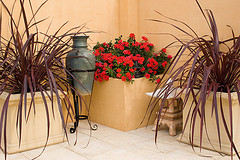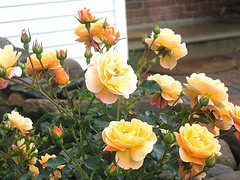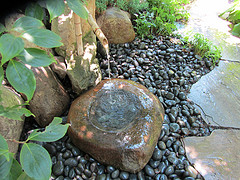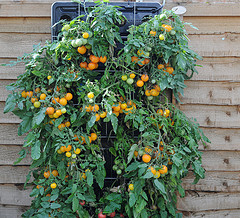
NEWS HIGHLIGHT
A look at garden trends for 2012
Forget
all those doomsday predictions about 2012. From the garden world’s
perspective, life will continue to be good – with gardeners saving
themselves water, hassles and misspent money. At least that’s according
to several savvy garden experts and a leading garden trends survey.
Nov. 8, 2011 – Forget
all those doomsday predictions about 2012. From the garden world’s
perspective, life will continue to be good – with gardeners saving
themselves water, hassles and misspent money. At least that’s according
to several savvy garden experts and a leading garden trends survey put together by Tesselaar Plants.
Water-wise plants, products
Most on the minds of landscaping professionals right now are issues
surrounding gardening and water, "whether it's the use of water or the
cleaning of water," says Sharon Coates, co-owner of Zaretsky and
Associates, a landscape design-and-build firm in Rochester, N.Y.
In light of recent droughts in places like Georgia, Texas and the Carolinas, people are trying to use the water they do
have more frugally, Coates explains. “People are making sure they’re
watering responsibly, choosing plants that aren’t water hogs and putting
rain sensors on their irrigation systems. They’re also making sure the
irrigation is monitored so it’s not watering the driveway and sidewalk.”
Water-wise plants will also make the Mediterranean garden style hot  in 2012, says Genevieve Schmidt, a northern coastal
in 2012, says Genevieve Schmidt, a northern coastal
California landscape designer and author of the North Coast Gardening blog.
Mediterranean landscape design, she explains, often features open and
airy courtyards, light-colored, textured hardscaping such as mosaic
walls, gravel beds or unglazed terra cotta pots and low-growing,
drought-tolerant plants, hedges, topiary trees and vines (i.e. olive,
bay and lemon trees, succulents, lavender, palms, roses and grasses).
“Of course, the vivid colors also help make this a winning style.”
Also, when it comes to cleaning the water, especially storm water
carrying pollutants like fertilizers and motor oil into local waterways,
many people are turning to rain gardens. “These shallow depressions are
filled with deep-rooted plants and grasses — all of them noninvasive,
native or locally adapted — that can handle being inundated with water
and also don’t mind being dry,” Zaretsky and Associates’ Coates says.
“Many gardeners are catching their own rainwater in rain barrels and
cleaning or recycling grey water (wastewater from domestic activities
like laundry, dishwashing and bathing)” adds Anthony Tesselaar,
cofounder and president of Tesselaar Plants. “In fact, in many
municipalities now, saving water is not only ‘in’, but mandatory”.
Black and amber
 Black
Black
and amber shades in plants continue to be a “hot” color trend, says
North Coast Gardening’s Schmidt. “People have already been bewitched by
the dark drama of black plants,” she explains, “and as they learn to
design with them more effectively, they’ll only become more popular.”
Amber shades, she adds, are also extremely popular – “amber
heucheras, the amber Flower Carpet roses, and other plants with amber
tones are going to be big in nurseries this year.”
Low-risk, high-value plants
Just as consumers are being more careful with their water usage,
they’re also shopping smarter. In particular, they’re looking for
low-risk, high-value plants that not only look good in the garden
center, but have a tried-and-true reputation.
“Plants bred to withstand attacks from pests and diseases that are
also tolerant of climate and soil extremes provide a better value,” says
Tesselaar (developer of the low-maintenance, disease- and
drought-resistant Flower Carpet® roses, Festival™ Burgundy cordyline, Storm™ agapanthus and Volcano®phlox).
“Gardeners are more aware than ever that choosing the right plant for
the right situation is imperative if you want to help save the planet —
let alone your bank balance.”
For as little as $15 to $25, for instance, you can have long-term
color without a lot of expense by using continuously flowering shrubs
like Flower Carpet roses, hydrangeas, potentilla (shrubby cinquefoil)
and spirea. Or, if your garden already has plenty of beautiful
structure, use such colorful, flowering machines to dress up these
‘good bones.’”
Smaller water features
More and more people are moving away from large ponds and toward smaller  water features, says Coates: “Now people prefer a cut piece of stone, a boulder or a beautiful glazed urn with water bubbling out of the top.”
water features, says Coates: “Now people prefer a cut piece of stone, a boulder or a beautiful glazed urn with water bubbling out of the top.”
Coates thinks it’s a maintenance issue: “People either have to be
really into ponds and all the maintenance they take, or they have to
hire someone to do it for them.”
Heavy metal
What’s more, says Schmidt, fountains made with natural stone or metal
are hotter sellers than features made of manmade materials. “The
ball-shaped fountains made of stone are very big this year,” she says,
“and I think that copper and other metals are coming into fashion as
accents in fountains and as materials for planting containers.”
Seasonal interest
In colder areas, where the blooms are gone and deciduous leaves have
fallen, Coates is seeing more people keep their ornamental grasses
instead of cutting them back, so they can provide winter interest. For
the same reason, they’re looking for plants with winter berries,
evergreens, barks of different colors and textures or deciduous trees
and shrubs with dramatic forms. But they’re also adding plants that
change with the seasons, offering new interest with each.
“Customers have grown tired of the stark, all-season gardens that
were so fashionable a decade ago,” Tesselaar says. “Every garden needs
its backbone of plants that look great year round, but that doesn’t have
to be at the expense of seasonal interest and color.”
More front yard gardens
The number of front yard gardens is also on a steady rise (29 percent
in 2011, compared to 27 percent in 2010 and 25 percent in 2009),
according to the Garden Trends Research Report’s Early Spring 2011
survey (conducted for the Garden Writers Association Foundation).
Meanwhile, the number of backyard gardens has taken a 3-percent hit,
down from 50 percent in 2009 and 2010.
Gardening “up”
Vertical gardening is also on the rise, as documented in the new, popular book  Garden Up! Smart Vertical Gardening for Small and Large Spaces
Garden Up! Smart Vertical Gardening for Small and Large Spaces
by California garden designers Susan Morrison and Rebecca Sweet. The
practice of growing plants up from the ground instead of out, or of
planting them off
the ground to start with—on trellises, arbors, balconies and walls—has
become especially popular among those with small spaces, landscape
eyesores or an awkward “skinny spot” in their garden.
But Coates also notes the growth of a different kind of “gardening up” – green roofs.
“Green roofs have definitely seen more of a commercial application
and have been done in mostly urban areas, but they’re still a huge
trend,” she says. “Green roofs help save on heating and cooling costs
and actually protect the roof underneath from the degrading effects of
the elements, so cities have received tax incentives for green roof
installations.” Some cities, like Toronto and Chicago, are even starting
to require green roofs on some new buildings, based on the
square footage.
About Tesselaar
Tesselaar Plants searches the world and introduces new plants for the
home garden, landscape, home décor and gift markets. Tesselaar Plants
undertakes extensive research and development of its varieties and, once
selected for introduction, provides marketing and promotional support
for its plant brands through its grower and retail network. Tesselaar’s
portfolio of plants is small by design, given rigorous standards that
result in high-quality, dramatic, prolific plants that are also
environmentally friendly and exceptionally easy to grow.
The Tesselaar philosophy is to introduce exceptional plants while
“making gardening easy” for everyone, so it makes them widely available
as possible. Tesselaar believes that the more gardeners there are, the
better it is for everyone.
Print this page